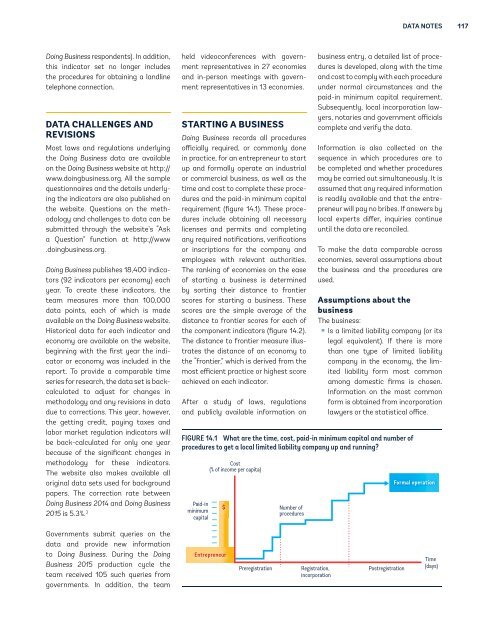bc8G2-7
bc8G2-7
bc8G2-7
You also want an ePaper? Increase the reach of your titles
YUMPU automatically turns print PDFs into web optimized ePapers that Google loves.
DATA NOTES<br />
117<br />
Doing Business respondents). In addition,<br />
this indicator set no longer includes<br />
the procedures for obtaining a landline<br />
telephone connection.<br />
DATA CHALLENGES AND<br />
REVISIONS<br />
Most laws and regulations underlying<br />
the Doing Business data are available<br />
on the Doing Business website at http://<br />
www.doingbusiness.org. All the sample<br />
questionnaires and the details underlying<br />
the indicators are also published on<br />
the website. Questions on the methodology<br />
and challenges to data can be<br />
submitted through the website’s “Ask<br />
a Question” function at http://www<br />
.doingbusiness.org.<br />
Doing Business publishes 18,400 indicators<br />
(92 indicators per economy) each<br />
year. To create these indicators, the<br />
team measures more than 100,000<br />
data points, each of which is made<br />
available on the Doing Business website.<br />
Historical data for each indicator and<br />
economy are available on the website,<br />
beginning with the first year the indicator<br />
or economy was included in the<br />
report. To provide a comparable time<br />
series for research, the data set is backcalculated<br />
to adjust for changes in<br />
methodology and any revisions in data<br />
due to corrections. This year, however,<br />
the getting credit, paying taxes and<br />
labor market regulation indicators will<br />
be back-calculated for only one year<br />
because of the significant changes in<br />
methodology for these indicators.<br />
The website also makes available all<br />
original data sets used for background<br />
papers. The correction rate between<br />
Doing Business 2014 and Doing Business<br />
2015 is 5.3%. 3<br />
held videoconferences with government<br />
representatives in 27 economies<br />
and in-person meetings with government<br />
representatives in 13 economies.<br />
STARTING A BUSINESS<br />
Doing Business records all procedures<br />
officially required, or commonly done<br />
in practice, for an entrepreneur to start<br />
up and formally operate an industrial<br />
or commercial business, as well as the<br />
time and cost to complete these procedures<br />
and the paid-in minimum capital<br />
requirement (figure 14.1). These procedures<br />
include obtaining all necessary<br />
licenses and permits and completing<br />
any required notifications, verifications<br />
or inscriptions for the company and<br />
employees with relevant authorities.<br />
The ranking of economies on the ease<br />
of starting a business is determined<br />
by sorting their distance to frontier<br />
scores for starting a business. These<br />
scores are the simple average of the<br />
distance to frontier scores for each of<br />
the component indicators (figure 14.2).<br />
The distance to frontier measure illustrates<br />
the distance of an economy to<br />
the “frontier,” which is derived from the<br />
most efficient practice or highest score<br />
achieved on each indicator.<br />
After a study of laws, regulations<br />
and publicly available information on<br />
business entry, a detailed list of procedures<br />
is developed, along with the time<br />
and cost to comply with each procedure<br />
under normal circumstances and the<br />
paid-in minimum capital requirement.<br />
Subsequently, local incorporation lawyers,<br />
notaries and government officials<br />
complete and verify the data.<br />
Information is also collected on the<br />
sequence in which procedures are to<br />
be completed and whether procedures<br />
may be carried out simultaneously. It is<br />
assumed that any required information<br />
is readily available and that the entrepreneur<br />
will pay no bribes. If answers by<br />
local experts differ, inquiries continue<br />
until the data are reconciled.<br />
To make the data comparable across<br />
economies, several assumptions about<br />
the business and the procedures are<br />
used.<br />
Assumptions about the<br />
business<br />
The business:<br />
• Is a limited liability company (or its<br />
legal equivalent). If there is more<br />
than one type of limited liability<br />
company in the economy, the limited<br />
liability form most common<br />
among domestic firms is chosen.<br />
Information on the most common<br />
form is obtained from incorporation<br />
lawyers or the statistical office.<br />
FIGURE 14.1 What are the time, cost, paid-in minimum capital and number of<br />
procedures to get a local limited liability company up and running?<br />
Paid-in<br />
minimum<br />
capital<br />
Cost<br />
(% of income per capita)<br />
$<br />
Number of<br />
procedures<br />
Formal operation<br />
Governments submit queries on the<br />
data and provide new information<br />
to Doing Business. During the Doing<br />
Business 2015 production cycle the<br />
team received 105 such queries from<br />
governments. In addition, the team<br />
Entrepreneur<br />
Preregistration<br />
Registration,<br />
incorporation<br />
Postregistration<br />
Time<br />
(days)


